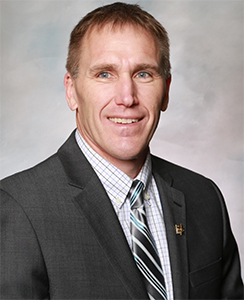Committed to Additional Education and Research to Improve Nutrient Management
 Livestock Farmers Face Challenges
Livestock Farmers Face Challenges
Al Wulfekuhle is the Iowa Pork Producer Association President. He knows the challenges that livestock farmers face. As a result, he has terraces, grassed waterways, field boarders and a wetland on his crop land.
Some pork producers in Iowa see the state’s Nutrient Reduction Strategy as an issue for crop farmers. After all, commercial scale hog operations are already more heavily regulated. They must have manure management plans and update them annually to the Iowa Department of Natural Resources.
However, the idea that nutrient management is for crop farmers who buy fertilizer is changing. This change in point-of-view is especially relevant among the leaders of the Iowa Pork Producers Association. In fact, IPPA already supports research on nutrient management at Iowa State University and is also a founder of the Iowa Agriculture Water Alliance.
“As we got deeper into this, it became pretty clear that we needed to do more,” says Al Wulfekuhle. Wulfekuhle is a northeast Iowa hog producer who took over as IPPA president in late January. “IPPA is committed to additional education and research to improve nutrient management.” IPPA is devoting a big share of its research support for nutrient management at ISU, says Wulfekuhle, who finishes hogs at 13 different sites around Quasqueton, Iowa, in partnerships with others. In addition, IPPA committed over $150,000 for water quality and environmental research this past year and committed nearly $300,000 to other water quality programs.
Nitrogen in the Soil Recaptured
Wulfekuhle knows the challenges livestock farmers face with nutrient management on cropland. He farms about 500 acres of his own land that’s already protected by conservation practices.
“We’ve done a lot of the basic things over the years,” he says. The farm has terraces, grassed waterways, field borders, and a two-acre wetland catching runoff from about 40 acres. Yet more is needed for the difficult task of managing the nitrogen and manure he uses as fertilizer. “You really can’t afford to run out in the summer time,” he says. Nitrogen losses can mean a corn yield shortfall of 50 bushels an acre.
Recapturing some of the nitrogen in the soil is possible. “According to ISU field trials at Nashua, a cover crop is really the only thing that makes a big difference,” he says.
Cover of Cereal Rye on Field of Soybeans
“Livestock farmers have their own barriers to cover crops,” he says. Still, Wulfekuhle plans to try a cover of cereal rye on his soybean fields this year. “I think we all know that long term, it’s good for the soil,” he says. Although Wulfekuhle has some reservations about state or federal programs to pay for cover crops, with farming margins tight and the cost of seeding at $30 to $40 an acre, it may be necessary for a while, he says.
Still, there are other opportunities for hog farmers in nutrient management. In fact, it may be possible for farmers to fine-tune the DNR guidelines for manure application rates with computer models similar to the Encirca program offered by Pioneer.
“For pork producers, it’s all about managing the nutrients that are in the manure,” Wulfekuhle says. If research finds ways to improve that management, it will be better for the environment and for farmers’ bottom lines. In conclusion, Wulfekuhle said, “I think it will be a win-win for everyone.”
